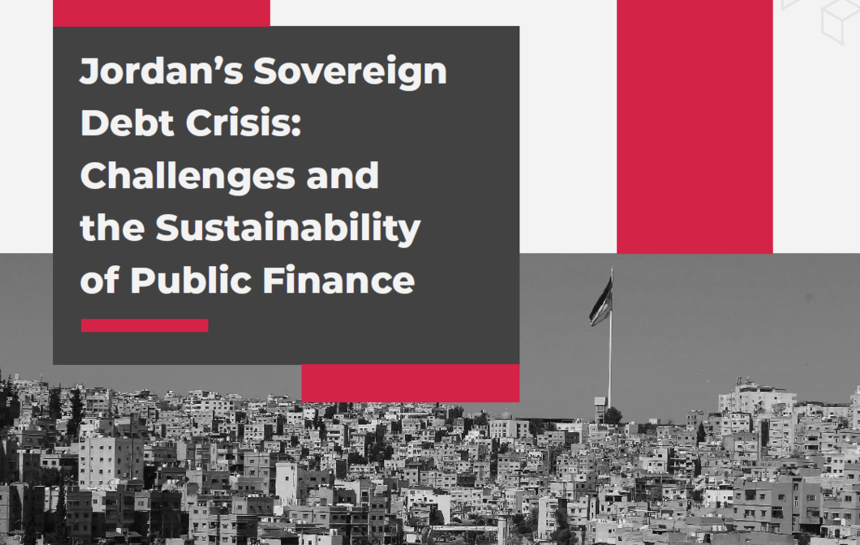
Jordan’s Sovereign Debt Crisis: Challenges and the Sustainability of Public Finance
by Ahmad Awad
Introduction
The Jordanian economy has long been characterized by a heavy dependence on foreign aid and debt, due to its limited natural resources, weak productive base, and the economic and political choices of successive Jordanian governments. Within this structural constraint, achieving self-sustaining economic growth has proven difficult, prompting Jordan to continually seek financial support from international donors and lenders. Despite various efforts to stimulate development, economic expansion in Jordan has remained sluggish, averaging just 2.5% annually over the past five years, while unemployment rates have hovered around 22% since 2020. The situation is further exacerbated by rapid population growth and the hosting of large numbers of refugees, which have increased pressure on public services, infrastructure, and the labor market. A combination of structural vulnerabilities, fiscal management decisions by successive governments, and external shocks has reinforced an economic model heavily reliant on borrowing and foreign aid, raising concerns about the long-term sustainability of Jordan’s financial system.
One of the primary challenges Jordan faces is its slow economic growth, which remains constrained by a low-productivity, service-based economy. This limits its capacity to generate high-value and sustainable economic activity. Furthermore, the private sector remains weak, with small and medium-sized enterprises (SMEs) struggling to access financing and scale their operations. As a result, job creation has been insufficient, leaving a growing segment of the labor force either unemployed or engaged in informal, low-paying jobs with little to no social protection.
The persistently high unemployment rates, particularly among young people and university graduates, reflect a deep structural gap between the education system and labor market needs. Although Jordan has invested heavily in higher education, many graduates face limited opportunities in their fields of specialization, pushing them to either accept low-skilled jobs or emigrate in search of better career and life prospects. The government’s inability to stimulate job growth in high-productivity sectors has aggravated social issues and fueled frustration among young Jordanians, compounding the economic challenges facing the country.
Chronic fiscal deficits in Jordan’s public budgets represent another core issue. These deficits averaged 7.4% of GDP (before grants) over the past five years, with similar or worse levels in preceding years. This has led successive governments to rely on external borrowing and foreign assistance to fund public expenditures. The general budget has long suffered from imbalances between revenues and expenditures, prompting policymakers to adopt a debt-financing approach to development. However, this model has resulted in a continuous accumulation of public debt, which rose from 99.9% of GDP in 2019 to 117.2% in 2024.
In an effort to address this deficit, Jordan implemented a series of austerity measures and tax increases under agreements with the International Monetary Fund (IMF). These measures included setting the general sales tax at a high rate of 16% on most goods and services, cutting subsidies, and imposing hiring freezes in the public sector. These steps led to higher living costs and a decline in the quality of public services, especially in healthcare and education. Despite these efforts, fiscal measures failed to generate sufficient growth in domestic public revenues. Most of the tax burden fell on consumption rather than income or corporate profits, with revenues from indirect taxes accounting for approximately 72% of total tax revenues. This disproportionately affected low- and middle-income citizens, leading to a decline in domestic demand and a slowdown in economic activity.
In addition to economic challenges, Jordan is also exposed to geopolitical risks and external economic shocks. The 2008 global financial crisis weakened foreign investment flows, while the aftermath of the Arab Spring in 2011 destabilized several countries in the region, negatively impacting trade, tourism, and remittances, although the latter eventually recovered. The Syrian refugee crisis also placed additional pressure on public services.
In recent years, the COVID-19 pandemic caused a sharp economic contraction of -1.1% in 2020, disrupting global supply chains and increasing pressure on public finances. The Russian-Ukrainian war further exacerbated Jordan’s economic fragility, as the country was severely affected by rising oil and gas prices, which increased transportation and production costs across various sectors. Additionally, the global surge in food prices intensified inflationary pressures, significantly affecting low-income households and deepening economic hardship. The ongoing genocide in Gaza for nearly 20 months, along with the renewed military occupation of the West Bank, introduced new risks by disrupting trade and investment flows and increasing regional uncertainty, which could hinder economic recovery efforts.
In response to these challenges, the government has continued to rely on external borrowing as a key strategy for managing public finances and securing resources for the national budget. It has obtained new loans from the IMF, the World Bank, and international capital markets to achieve financial stabilization, in addition to increasing borrowing from the Social Security Fund. However, these debt-based policies have failed to achieve sustainable economic growth, as most borrowed capital has been directed toward covering current expenditures and debt servicing rather than investments that drive real economic development. With the continued rise in debt servicing costs and an increasing share of government revenues being consumed, Jordan’s financial stability remains in question, highlighting the urgent need for reforms to enhance fiscal sustainability and economic resilience.
This paper examines the trajectory of the Jordanian economy through a political economy lens, assessing structural constraints, fiscal policies, the country’s dependence on debt, the role of international financial institutions, and the sustainability of public debt. Debt sustainability is defined as the state’s ability to meet its current and future financial obligations without resorting to further borrowing to repay existing loans, or accumulating debt levels that become unpayable, and without negatively affecting the drivers of economic growth and social spending.
By analyzing both domestic and external factors, the paper aims to provide a comprehensive picture of Jordan’s economic challenges and offer insights into potential pathways toward sustainable growth and financial stability.